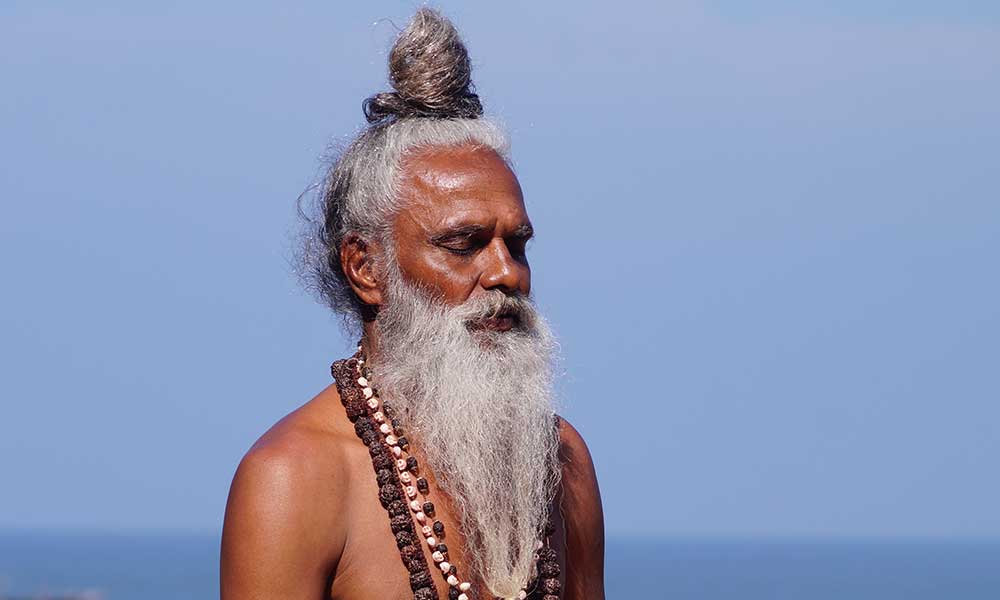For ages, yoga has been practiced as both a physical and spiritual discipline.
If you practice yoga regularly in the western world, you may be familiar with some of the more common yoga styles like: Hatha, Bikram, Yin, and Vinyasa.
Modern yoga practices have branched off into various subtypes including everything from Vinyasa to goat yoga and everything in between.
Well-known for its abundance of physical and mental health benefits, yogic practices have been around forever and are only increasing in popularity.
So, how did this practice start and where did it come from?
Keep reading to learn more about how the ancient practice of yoga began.
What was the original purpose of yoga?
Yoga was developed as a spiritual discipline, based on indefinite scientific findings, that is intended to create a sense of harmony between the mind and body.
It exists as both an art and science of health and wellness.
The word yoga was derived from the Sanskrit word “Yuj,” which means ‘to join’ or ‘to yoke’ or ‘to unite.’
Yogic scriptures cite that practicing yoga will ultimately lead to the joining of individual consciousness and Universal Consciousness.
This union makes for a perfect harmony between the mind and body, while connecting us deeply to nature.
Some modern day scientists believe that all things that exist in the universe are simply a manifestation of the same quantum firmament.
Those who are able to experience this oneness in their everyday life are believed to be in a state of yoga.
These people, having attained a mental and spiritual state of freedom that is otherwise known as mutki, nirvana, or moshka, are called “yogis.”
To summarize, the purpose of yoga is self-realization, to conquer suffering and mental anguish, and ultimately reach a state of liberation.
Living freely in all aspects of life, health and harmony is the intended goal of yoga practice.
Yoga is also widely considered to be an inner science consisting of a multitude of methods to help humans achieve mastery over their destiny.
What is the history and origin of yoga?
The practice of yoga first came to be during the Indus-Sarasvati civilization in Northern India approximately 5,000 years ago, long before the first religions or belief systems came to fruition.
According to yogic legends, Shiva was the first yogi or Adiyogi and the first Guru.
It is said that during this time, Adiyogi delivered his knowledge to the “seven sages” or Saptarishis.
The sages then took this powerful yogic science and distributed it throughout Asia, the Middle East, North Africa and South America.
Agastya, the sage who wandered all through the Indian subcontinent influenced Indian culture to be heavily aligned with a yogic way of life.
Though similarities have been found in ancient cultures all over the world, India is where yoga blossomed into its fullest expression.
Ancient scriptures, seals and fossils tell us that yoga existed in ancient India.
Many fossils show symbols of different figures performing Yoga Sadhana while seals of idols of mother Goddess also exist.
These artifacts are suggestive of Tantra Yoga.
Who first invented yoga?
While there is substantial evidence to prove that yoga was around during the pre-Vedic era, the great Sage Maharshi Patanjali was the one to set in stone the practices of yoga, yoga philosophy, and other related knowledge that was known at the time.
Patanjali organized his existing knowledge of yoga through the creation of his Yoga Sutras.
The legacy of Patanjali’s Yoga Sutras lived on long after his time, and was contributed to significantly by other Sages and Yoga masters.
In fact, the period between 500 BC – 800 A.D. is known as the Classical period of yoga and is widely considered to be the most monumental moments in history relating to the buildout of yoga.
In this timeframe, Vyasa’s commentaries on Yoga Sutras and Bhagawadgita came to be.
The Classical period of yoga is also an era where Mahavir and Buddha, two of the most eminent religious teachers of India, made their mark.
Mahavir’s Five Great Vows and Eightfold Path by Buddha are famously considered to be the early nature of Yoga sadhana.
The Westernization of Yoga
Yoga was around for a long time before it made its way to Western civilization.
In around 500 BCE during the Silk Road, yoga practice began to spread throughout Asian.
Every time it flowed through a new region, the practice of yoga would slowly mold to fit each new culture.
By the 20th century, yoga began to spread beyond the confines of these regions and dip its toes into Western culture.
In the 1800s, many Westerners began traveling around the world to be trained in Ashtanga Yoga by “gurus.”
For this reason, Guru culture played a significant role in the westernization of yoga.
In 1893, Swami Vivekananda introduced the practice of yoga at the Parliament of the World’s Religions in Chicago, Illinois.
Swami was the first Indian Hindu monk to ever make his way to the West, inspiring the nation’s curiosity by demonstrating a series of yoga postures.
Decades later, Indian monk and guru Paramahansa Yogananda initiated further discovery of yoga in the West by holding a conference of religious liberals in Boston.
His guru, the ageless Babji, sent him to spread awareness of Kriya Yoga to the West.
When the Immigration Act of 1924 took place, it became extremely difficult for Indian gurus to travel to the West, meaning that Westerners had to travel to yoga to learn yoga teachings.
These yogis would return to the United States to teach their knowledge of yoga to others.
Though physical practice is surely not the only puzzle piece of yoga, Asanas (bodily postures) became particularly popular amongst Westerners.
Western culture’s emphasis on Asanas in yoga
As we know, the physical practice only accounts for one limb on the yoga tree.
So how did something that began as a spiritual practice become so physical in the West?
The answer to this question dates back to the 19th century, when westerners began placing a high importance on the physical body as opposed to other things.
Physical culture became a thing when the masses became obsessed with ideas of manliness, morality, and patriotism.
It has been speculated that Western culture’s obsession with the perfect modern man perpetuated the idea that physical activities should be prioritized.
This is said to have shaped the way that the practice of yoga was transferred to Western culture with a much higher emphasis on the physical practice than on spiritual liberation or meditation practices.
Is yoga a religion?
Yoga has touched various cultures all over the world, spreading slowly over a span of thousands of years.
For this reason, the word yoga can mean different things to different people.
While it might have a spiritual meaning to some, to others it could just be a physical practice used to stretch.
However, to fully appreciate the benefits of all that this practice has to offer, it’s important to recognize where the roots of this practice sprouted.
The essence of yoga was intended to be a spiritual pathway to spark transformation of the soul.
Yoga was meant to connect us to our higher self as well as universal consciousness.
Though its nature is inherently spiritual, it is not necessarily a religion.
This is because religions tend to come in more formal packages, with defined sets of rituals and obligations.
Yoga is not this way, unless of course, you are considering the self-discipline of a regular yoga practice to be an obligation or ritual.
While yoga does share a lot of similarities with a lot of common religions (such as personal contemplation, achieving a personal sense of peace, and searching for a deeper life meaning or purpose), it would be more on the mark to define yoga as a spiritual practice rather than a religious one.
This is not to say that yoga has no connection to any religions whatsoever.
Even though the practice of yoga is not a religion on its own, it stems from Hindu, Jain, and Buddhist religions.
For example, in both Buddhist and Hindu religions, the sacred mantra ‘Om’ is chanted during meditative practices to reverberate the sound of harmony in the universe.
However, you can still chant ‘Om’ during mantra yoga without being a part of a religion.
This is because the mantra itself is not religious, but instead it is a method of connecting to others around you and the universe.
While much of modern yoga is no longer religious, the practice has still managed to preserve the art of self-reflection and contemplation.







